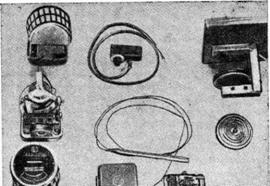Automatical Electric Drive Controls
Thermostats. A thermostat is a switch, but it is a special kind of switch. Its switch contacts must open and close automatically in response to1 changes in temperature. A thermostat 18 therefore an automatic electric switch used for temperature control.
Classified according to usage, there are two general types of thermostats. The type for heating equipment has contacts which close when temperature decreases. When the temperature increases up to some predetermined value,2 the contacts automatically open and disconnect the heating equipment. If the temperature decreases a small amount (usually 1° to 4° F) below this predetermined value, the contacts close and the heating unit functions, raising the temperature bask to the original value. The other type of thermostat is for cooling and has contacts which close on a temperature rise. When the temperature increases up to a certain value, the contacts of the thermostat close and start an air-conditioning unit, a fan, or a refrigerator. When the temperature is back down to the desired value, the contacts open and stop the cooling equipment.
Thermostats are undoubtedly the most widely used type of automatic control and already have found many applications on the farmstead. They are used in hot-water systems, electric hotbeds, electric brooders, electric incubators, refrigeration systems, crop driers, ventilating-fan cooling systems, electric stock waterers, electric ovens, and electric irons and for controlling the heating system of the farm residence and other farm buildings. Several different types of thermostats are shown in Fig. 14.
It does not matter whether the thermostat is to be used for heating or for cooling; its switch contacts could be operated by the action of a bellows. A bellows is like a balloon in that It expands when the pressure inside is increased and contracts when the pressure is decreased. Actually, the bellows lengthens and shortens rather than changing in diameter. The change in the length of the bellows trips and resets the switch mechanism, and so to understand why the switch contacts open and close, it is necessary to know why the pressure inside the bellows changes in amount.
The bellows3 is connected by a small metal tube to a metal bulb which contains liquid and gas. When the liquidinside the bulb is heated, it begins to boil (evaporate) and change into gas. The additional gas created by the boiling liquid causes an increase in pressure inside the bulb, the tube, and the bellows. The bellows will expand (get longer), owing to this increase in pressure. When the gas inside the bulb is cooled, it begins to condense thereby changing back into the liquid form. Less gas means less pressure inside the

Fig. 14. Thermostats used on farms. The air switch shown on the left has a coiled bimetallic strip which operates a mercury switch. The bellows type with bulb and capillary tube, the bimetallic-strip type, and the wafer type are also pictured in this figure.
bulb, the tube, and the bellows. Owing to the decreased pressure, the bellows contracts (gets shorter) .and allows the switch contacts to change position. It is significant to realize that the switch contacts are opened and closed in accordance with the temperature surrounding the metal bulb; therefore the location of the metal bulb is very important. The location of the thermostat itself is not important in controlling temperature, but the length of the tube which connects the bellows to the bulb must be considered when planning the various installations4.
The amount of pressure required for expanding the bellows and operating the switch contacts is influenced by spring tension. The tension is adjustable and opposes the expansion of the bellows. The gas pressure inside the bellows will then have to be greater before the bellows can expand. Accordingly, the switch contacts will not be operated until the temperature increases, thus resulting in a greater gas pressure. Most metals expand when heated, but they do not expand the same amount. Two unlike metals which expand different amounts with an equal change in temperature provide the important mechanism in a bimetallic thermostat. The unlike metals are bonded together into one unit, and when the surrounding temperature increases, one metal expands more than the other, which causes the unit to bend. This bending action is used to trip and reset the switch contacts. Refer to Fig. 9 for an illustration of the bimetallic-strip principle, but real.ize that the bimetallic strips of a thermostat automatically reclose and do not need to be manually reset is do the contacts of the unit shown in this figure.
Usually this type of thermostat is cheaper than the bellows type. It has fewer parts. However, it differs in application in that the thermostat itself must be placed in the location where the temperature control is desired. This placement is necessary since the bimetallic strip is the item that responds to temperature changes, and it is mounted inside the thermostat housing. In the bellows type the bulb responds to the changes, and it is separated from its associated thermostat housing. The wafer thermostat is the cheapest of the three types that are used on the farm in connection with electric heating. It consists of two hollow metal disks5, the switch mid its contacts, and a frame for holding the parts in place. The metal disks are filled with gas. When the gas is heated, the pressure increases and the disks expand. The expansion pushes the switch contacts open. When the disks are cooler, they contract and the switch contacts close. The thermostat is not calibrated in degrees, but this may be done locally. Like the bimetallic type, the entire thermostat must be located at that position where the temperature is to be controlled.
Notes:
1in response – в ответ на…
2predetermined value – предопределенная величина
3the bellows – мембрана, сифон
4installation - установка
5hollow metal disk – полные металлический диск
Вариант№ 5
